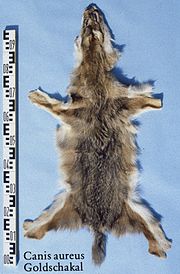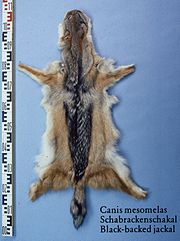Jackal skin
Among the jackals are three wild dog species, the golden jackal , the black-backed jackal and the striped Jackal . Jackal skins are usually only made into blankets because of their not quite as appealing hair structure, skins from mountainous areas are occasionally also used for trimmings and hats. As a rule, only the golden jackal's skins come on the market.
The durability coefficient for jackal fur is given as 60 to 70 percent.
species
- The home of the golden jackal , sometimes also called the gold wolf, stretches from southeastern Europe, the Middle East and South Asia to the north of India, and it lives in the north and east of Africa and in the Asian high mountains above 1000 meters.
- The winter color is different, due to the overlying blackish awning tips, from rust to gold. The front part of the muzzle, the forehead and the area around the eye sockets are ocher-rust-brown-fox-red, there is a blackish stripe above the eyes. The ears on the outside are pale rust brown, with cloudy, whitish hairs on the inside. The guard hairs on the back are specially developed, becoming less on the flanks, which makes the color look livelier and purer. The belly is whitish, slightly reddish in the armpits and quiet areas. The legs are ocher-fox-red, lighter on the inside. The tail is bushy, partly blackish, partly pale yellow with blackish lines above. The fur is about 70 to 85 centimeters long, the bushy tail 22 to 28 centimeters. The birth dress is light to dark gray; at the age of one month it changes to fox-red, speckled with black. In August / September the young animals resemble the adults and in October / November they already have a complete winter coat. From November to March the fur has developed an undercoat, which is missing in summer fur. The summer fur is sparse, coarse and short with the color distribution corresponding to the winter fur. In autumn, from mid-September to, the summer guard hairs fall out and the lower hair forms at the same time. The hardening runs from the cross over the back, flanks, stomach, limbs to the head and is completed at the end of November. There is no difference in fur between the sexes, only between the regions of origin.
- The winter fur is most beautiful in the period from November to March. Nevertheless, it is of little value because at this time the hair cover is coarse and sparse, and the color is monotonous and unappealing.
- The black-backed jackal lives in the more open areas from Nubia, Sudan, Somaliland to Cape Country.
- Due to its striking color, it should not be confused with the other jackal species. The slate-colored back, which looks like a saddle pad, stands out sharply against the light, rust-red dewlap on the underside. The fur is 70 to 85 cm long, the tail is gray with a gray to yellow-red tail and 30 to 35 cm long.
- The striped jackal occurs exclusively in sub-Saharan Africa, from the West African coast in Guinea and Senegal via central Africa to Sudan and Ethiopia in East Africa and from there south to Namibia, Botswana and northern South Africa.
- It has longer legs than the former and a thicker hairy, darker tail, which usually has a white tip. The color of the fur is brownish-gray with a reddish-pale back, on each side it has a more or less sharply defined light stripe, which is usually lined with black below. The fur is about 80 to 90 centimeters long, the tail 30 to 35 centimeters.
The hair of all three types is coarse and hard and somewhat thinning, and the undercoat is not very soft either. The geographical differences are considerable. The softest skins come from the Persian mountains, but probably never in large numbers. In general, it can be said that the coarser the hair is, the closer it is to the coast, the finer the hair, the further and higher the habitat inland.
When fur animals are divided into the hair fineness classes silky, fine, medium-fine, coarse and hard, the jackal hair is classified as hard.
Jackal type describes a hair type in which, like the jackal, the leading hairs with a light ring against the root tip (subapical) are predominant.
trade
The fur attack is low, mostly only golden jackals come into the trade. They came onto the market for the first time around 1900, and around 1910 they were traded in large quantities on the Leipziger Brühl , the most important world trade center for tobacco products at the time . At the time, most of the skins came from Greece.
The Russian trade standard names two traditions, Caucasian and Central Asian.
- Varieties I. full-haired; II. Less full-haired; III. half-haired; IV. Thinly haired.
The skins are usually cut open, not peeled off round.
For the skins traded as South American “jackals” , sometimes also as South American foxes , see → red fox fur .
Processing, history
As early as the beginning of 1900, the soft-haired pelts were being processed into clothing, probably mainly for men's clothing ( motorist or travel furs , inner linings and trimmings for furs ). Trimmings and hats were made from the better skins, which come from mountainous areas (some colored like marten or sable). The hard guard hair can be made a little softer by a suitable fur finish. When bleached, jackal skins were sometimes used as a roof imitation. Around 1920 to 1930, when fox colliers (animal- shaped scarves) were very much in vogue, jackal skins that were dyed accordingly were also used as a substitute for foxes - but " with a much more modest effect ".
Before living spaces and vehicles were generally heated, fur blankets were important objects of daily use and trade. Blankets made of jackal skins were attractive because of their wide, light vertical stripes. The most beautiful jackal skins were those from the then German Southwest Africa , today's Namibia . The locals used it to make square blankets, called bodies , which were folded in the manner of a scarf and carried with the fur towards the body. They were also on sale at the time.
In 1989, the approximate material consumption at that time for a women's coat of clothing size 40 with up to 14 jackal skins was given.
The processing corresponds to that of other long-haired fur , such as wolf fur or fox fur .
Today jackal skins are mainly used for trimmings, for making-up and also for blankets.
Numbers and facts
- 1907–1910, for these years the world yield of jackals was estimated at 20,000 to 30,000 animals. Of these, 10,000 came from Africa, 5,000 from Asia and 5,000 from Europe.
- Before 1911, between 5,000 and 10,000 Greek jackal skins were sold every year. The average value was 2 to 3 marks.
- Jackals were hunted in large numbers in India at that time, but they were rarely traded.
- In Algeria the government paid 1.50 francs shooting bonus, around 30,000 to 40,000 were killed each year. However, the skins were rarely carried out.
- From what was then German South West Africa , today's Namibia, several hundred of the attractive local variety were imported to Leipzig every year.
- In 2014, Nelson Mandela (* 1918; † 2013), in the house in which he lived from 1946 to 1962, still has a jackal skin on the bed , a sign of royal descent. Mandela was a South African anti-apartheid fighter and politician, and from 1994 to 1999 the first black president of his country.
Web links
annotation
- ↑ The specified comparative values ( coefficients ) are the result of comparative tests by furriers and tobacco shops with regard to the degree of apparent wear and tear. The figures are not unambiguous; in addition to the subjective observations of durability in practice, there are also influences from fur dressing and fur finishing as well as numerous other factors in each individual case . More precise information could only be determined on a scientific basis. The division was made in steps of 10 percent each. The most durable types of fur according to practical experience were set to 100 percent.
- ↑ In addition, the author notes (slightly modified formally): “The number of individual hides to be provided for a specific fur product can by no means be specified in advance. The decisive factors for this are primarily the prevailing fashion aspects, such as width, length, collar and sleeve shapes. The information can at best provide clues, especially since the original size of the hide is subject to changes due to more or less strong influences during conservation and fur finishing , but also within the skinning process. The numbers also allow conclusions to be drawn about the different body sizes of the animals. "
Individual evidence
- ^ A b c d e Christian Franke, Johanna Kroll: Jury Fränkel ´s Rauchwaren-Handbuch 1988/89 . 10th, revised and supplemented new edition. Rifra-Verlag, Murrhardt, pp. 130-131, 144.
- ↑ Paul Schöps, H. Brauckhoff, K. Häse, Richard König , W. Straube-Daiber: The durability coefficients of fur skins. In: The fur trade. Volume XV, New Series, No. 2, 1964, Hermelin Verlag Dr. Paul Schöps, Berlin / Frankfurt am Main / Leipzig / Vienna, pp. 56–58.
- ↑ a b Heinrich Dathe , Paul Schöps et al.: Pelztieratlas . VEB Gustav Fischer Verlag, Jena 1986, p.
- ↑ a b K. Toldt: Structure and natural coloring of the hair coat of wild mammals . Publisher German Society for Small Animal and Fur Breeding, Leipzig 1935, pp. 116, 139.
- ^ A b Max Bachrach: Fur. A Practical Treatise. Prentice-Hall, New York 1936, pp. 237-239. (engl.)
- ↑ Paul Schöps, Kurt Häse: The fineness of the hair - the fineness classes. In: The fur trade. Vol. VI / New Series, No. 2, 1955, Hermelin-Verlag Dr. Paul Schöps, Leipzig / Berlin / Frankfurt am Main, pp. 39–40 (note: fine (partly silky); medium-fine (partly fine); coarse (medium-fine to coarse)).
- ↑ a b c d e f Emil Brass : From the realm of fur. 1st edition. Publishing house of the "Neue Pelzwaren-Zeitung and Kürschner-Zeitung", Berlin 1911, pp. 445–447.
- ↑ Alexander Tuma: Pelz-Lexikon. Fur and rough goods. XXI. Tape. Verlag Alexander Tuma, Vienna 1951. Keyword "Jackal"
- ↑ Thomas Edward Eden, Jr .: The Search for Nitre, and the True Nature of Guano; Being an Account of a Voyage to the South-West Coast of Afric . General Books LLC, 2009. Last accessed January 16, 2014.
- ↑ Helmut Lang: Fur . Deutscher Fachverlag, Frankfurt am Main 1989, ISBN 3-87150-314-2 , pp. 39-40.
- ^ FF Aliew: Fur animal populations in the wild. In: The fur trade. Vol. XX. New series No. 6, 1971, Hermelin-Verlag Dr. Paul Schöps, p. 15 (after Kaplin, 1960)
- ^ Andreas Felber: Johannesburg: Aparter in picture and sound. In: The Standard. Rondo, February 10, 2014, last accessed January 17, 2014.



